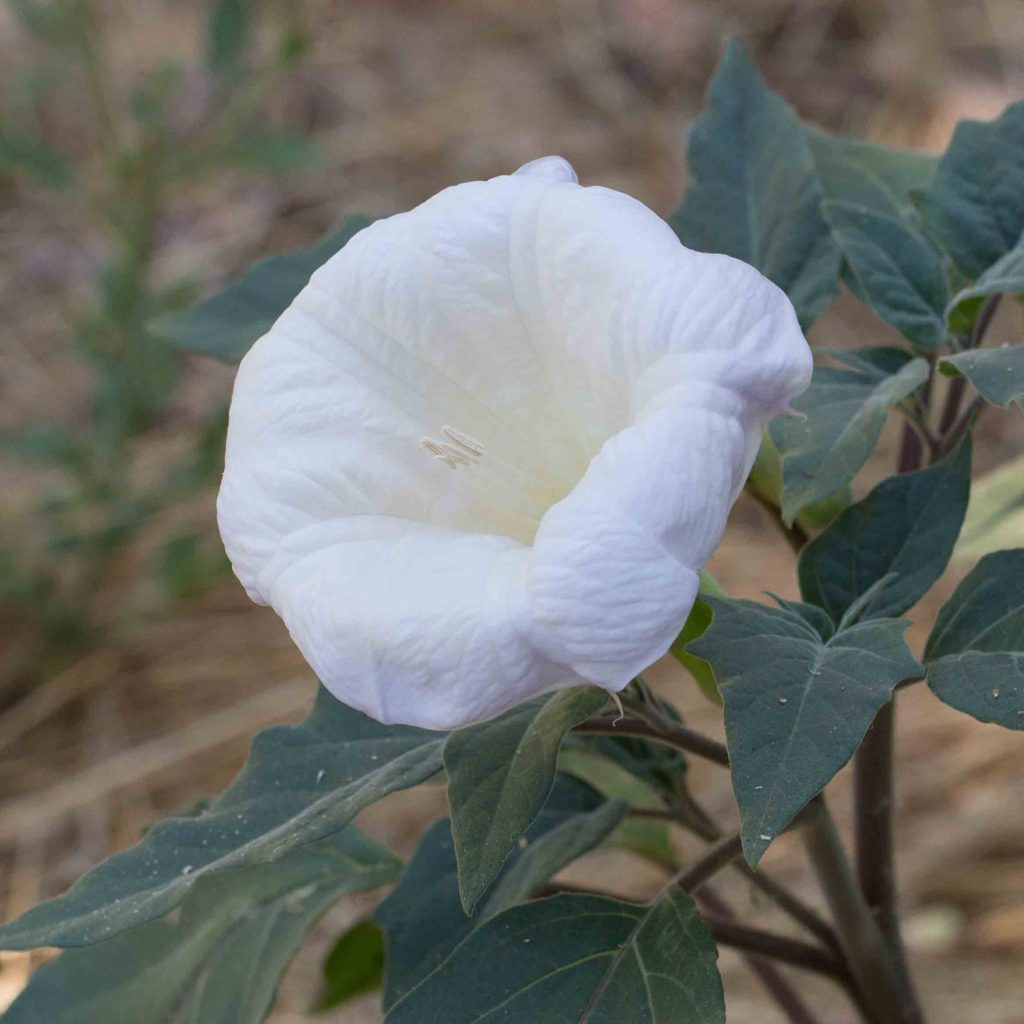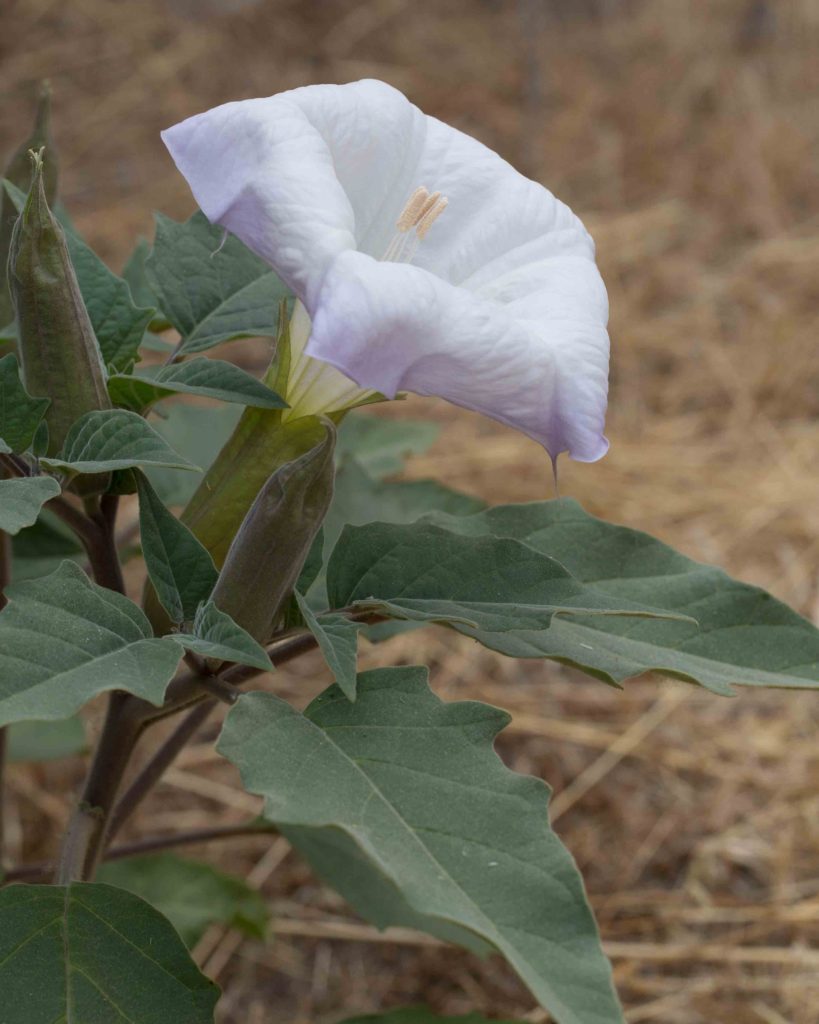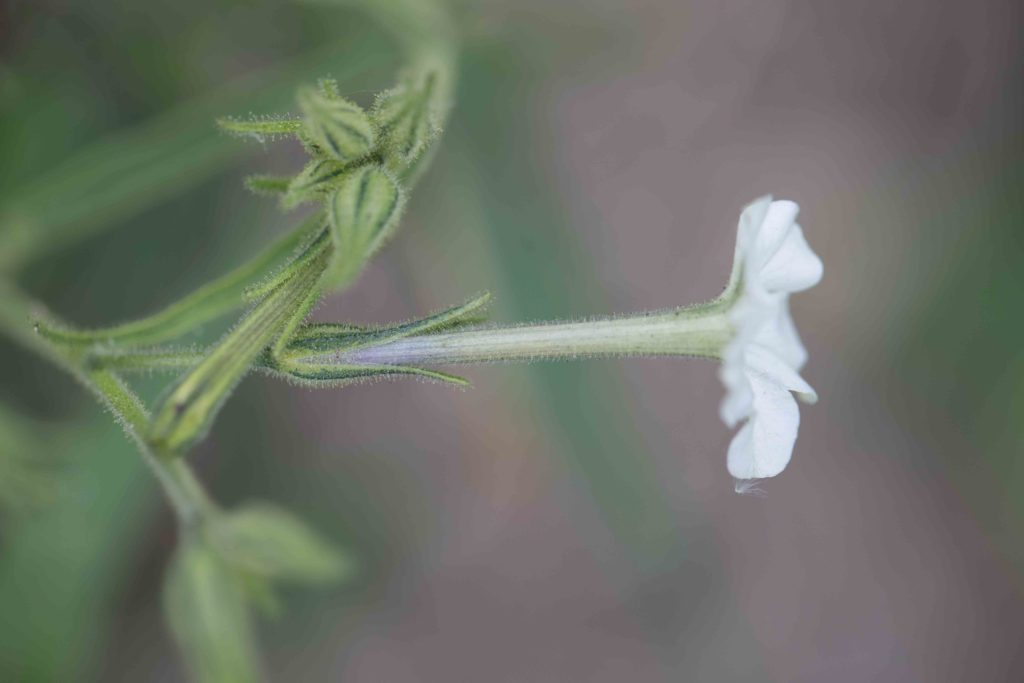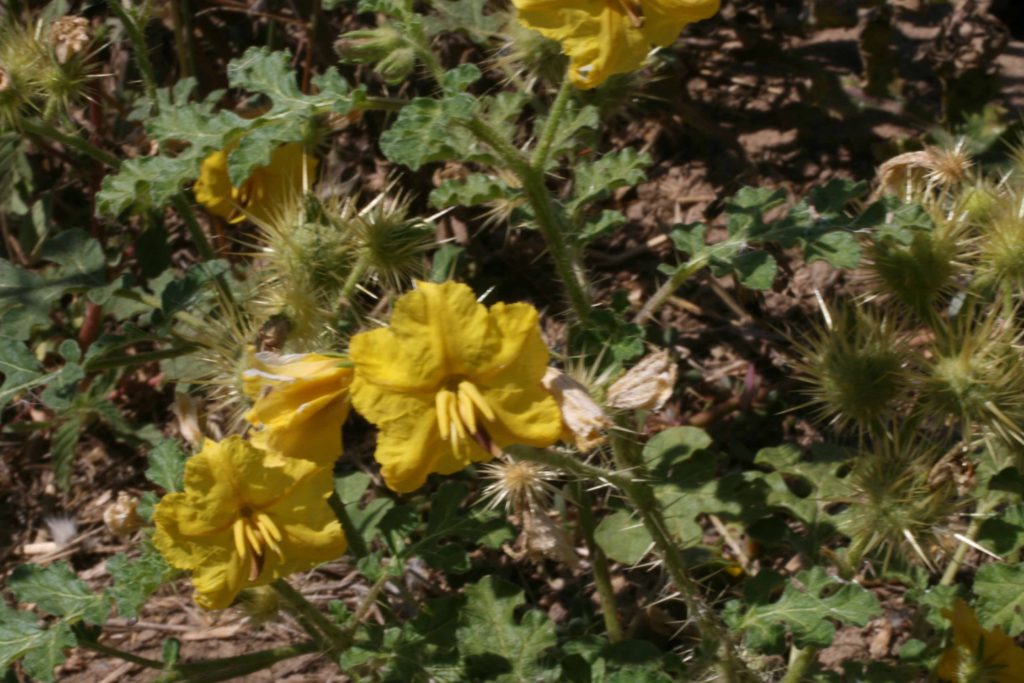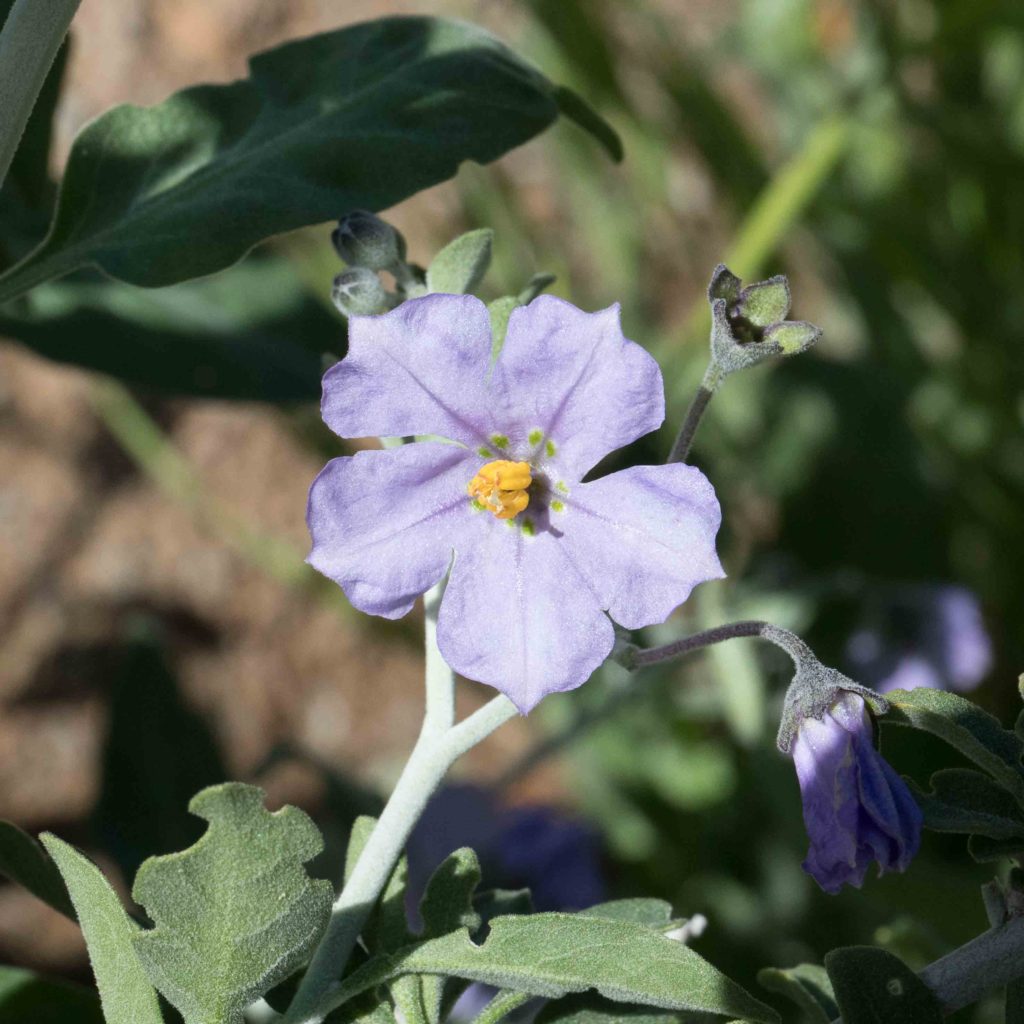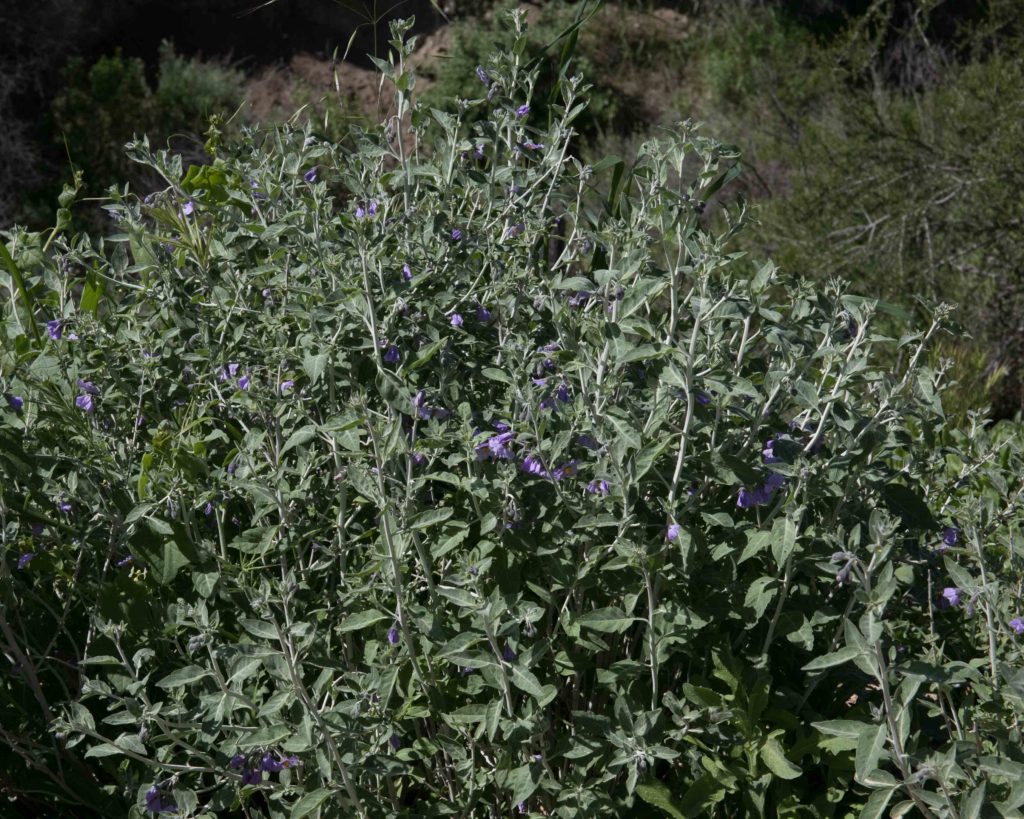Solanaceae: Nightshade Family
Many members of this family are seriously toxic. The name Nightshade, especially when prefixed by “Deadly” rather gives the game away. The genus Datura is notoriously toxic and hallucinogenic. Even such culinary staples as potatoes, tomatoes, bell peppers and eggplants, which all belong to this family, can be toxic if the wrong parts (e.g. the green parts and unripe fruits) are eaten.
Jimson Weed – Datura stramonium
Blooms:
June–Aug
Plant Height:
< 100 cm
Flower Size:
Large
Origin:
Mexico
Habitat:
Sandy open places
Notes:
This plant is easily recognized by its large (15 cm), sour-smelling, glabrous leaves. Also distinctive are the white to violet tinged, trumpet-shaped flowers, 6–9 cm long with 5 sharp-tipped lobes. The fruit is large, erect and oblong, with stiff prickles. The flowers open in the evening, and close early to mid-morning. Photos #1 and 3 by CJH.
Tolguacha / Western Jimson Weed – Datura wrightii
Blooms:
Apr–Oct
Plant Height:
50–150 cm
Flower Size:
Large
Origin:
Native
Habitat:
Sandy or gravelly open places
Notes:
This plant resembles Jimson Weed (Datura stramonium, see above), but with several differences. The large leaves are felty, with a strong, sweet smell. Also, the white to violet tinged, trumpet-shaped flowers are larger (15–20 cm), and often have rolled back margins. The fruit is pendulous rather than erect. It shares Jimson Weed’s hallucinogenic and toxic properties.
Tomato – Lycopersicon esculentum
Blooms:
Summer & fall
Plant Height:
Erect to vine-like
Flower Size:
Small
Origin:
South America
Habitat:
Escape from cultivation
Notes:
This plant needs little comment. Occasionally escaping from cultivation, it is easily recognized by its yellow flowers and, of course, by its fruits.
Many-flowered Tobacco – Nicotiana acuminata var. multiflora
Blooms:
Apr–Oct
Plant Height:
50–150 cm
Flower Size:
Large
Origin:
South America
Habitat:
Open, sandy or gravelly areas
Notes:
This is similar to Indian Tobacco (N. quadrivalvis, see below). The plant itself is very leafy, the leaves being petioled and ovate. The upper leaves are reduced in size, densely glandular-hairy, with a strong, unpleasant smell. This species is identified by the dark green stripes on its narrowly lanceolate calyx lobes. The petioled leaves and the dark stripe on the calyx lobes distinguish this from Indian Tobacco. Also, the flowers are smaller, the tube 30–40 mm long and 10–20 mm across. The plant is not uncommon in the south eastern parts of the county within the Diablo range, but has only recently been found elsewhere.
Tree Tobacco – Nicotiana glauca
Blooms:
Apr–Aug
Plant Height:
2–8 m
Flower Size:
Large
Origin:
South America
Invasive?
Yes – moderate
Habitat:
Roadsides and open, disturbed areas
Notes:
This is a large shrub or small tree. It has many clusters of narrow, yellow tubular flowers (3–3.5 cm long), with slightly flared lobes. The leaves are glaucous and bluish in color, broadly ovate and 5–21 cm long.
Indian Tobacco – Nicotiana quadrivalvis
Blooms:
May–Oct
Plant Height:
0.3–2 m
Flower Size:
Large
Origin:
Native
Habitat:
Open, well-drained washes, slopes
Notes:
The long tubular flowers are immediately recognizable as a tobacco. They are fully open for only a few hours in the morning. The plant itself is leafy, the lower cauline leaves being short-petioled and elliptic to ovate, the upper reduced in size, generally lanceolate and sessile to clasping. The plant is glandular-hairy and has a strong, unpleasant smell. This is similar to the Many-flowered Tobacco (N. acuminata var. multiflora, see above), but can be distinguished by the sessile to clasping upper cauline leaves, and by the absence of a dark green stripe on the calyx lobes. The flowers are also slightly larger, with the tube being 25–50 mm long, and the lobes 20–50 mm across.
Small-flowered Nightshade – Solanum americanum
Blooms:
Apr–Nov
Plant Height:
30–80 cm
Flower Size:
Very small
Origin:
Native
Habitat:
Damp fields and waste places
Notes:
This is similar to the more common Douglas’ Nightshade (Solanum douglasii, see below). But its flowers are smaller (3–6 mm across), white to pale lavender, and its styles project less (or not at all) beyond the anthers. More important, the sepals are strongly reflexed at maturity, most noticeable on the glossy black berries. The flowers are arranged in definite umbels, often pendulous, especially in fruit.
Douglas’ Nightshade – Solanum douglasii
Blooms:
All year
Plant Height:
up to 2 m
Flower Size:
Small
Origin:
Native
Habitat:
Shady slopes near coast
Notes:
This is a common straggling shrub, with small (about 1 cm across) white to lavender flowers in loose umbels. The bright yellow anthers are much longer than the filaments, and more or less adhere to form a cylinder round the exserted style. Note that the sepals are not reflexed in fruit (or only barely). This contrasts with Small-flowered Nightshade (Solanum americanum, see above). The poisonous berries ripen black.
Buffalo-bur – Solanum rostratum
Blooms:
May–Sept
Plant Height:
10–70 cm
Flower Size:
Large
Origin:
Great Plains
Habitat:
Disturbed areas, roadsides, fields
Notes:
This is easily recognized by its large, bright yellow flowers and its densely prickly appearance, especially its fruits. The anthers are the same color as the flower, unequal in length with one curved; the style also is curved. Leaves are 5–15 cm long , coarsely textured with deeply cut lobes. Note: sometimes commonly called Buffalo Berry, but this risks confusion with Shepherdia argentea, a member of the Russian Olive family (Eleagnaceae), which has more approachable fruits which were apparently used as a flavoring for bison meat.
Photographs reproduced by permission of Frank Wilson
Blue Witch – Solanum umbelliferum
Blooms:
All year
Plant Height:
< 1 m
Flower Size:
Medium
Origin:
Native
Habitat:
Chaparral & coastal scrub
Notes:
This is a common, densely hairy, leafy shrub with many lavender to blue-purple flowers. The leaves are 1–4 cm long, soft grayish-green, elliptic to ovate and generally entire. Flowers arenodding, 16–25 mm across, with thick yellow anthers surrounding the style. At the base of each petal, there are two small, green-centered, white dots. Fruits are white, green near the base. Photos #1 and 4 by CJH.
Chaparral Nightshade – Solanum xanti
Blooms:
Feb–June
Plant Height:
40–90 cm
Flower Size:
Medium
Origin:
Native
Habitat:
Dry slopes & canyons, woodland and shrublands
Notes:
This is similar to Blue Witch (Solanum umbelliferum), but far less common. The flowers are similar, and there are subtle differences in the hairs on the stem, but the most noticeable difference is in the leaves. They are larger (2–7 cm long), lanceolate to ovate, with an obtuse to cordate base, and entire or one or two-lobed at the base. Fruits are greenish.




